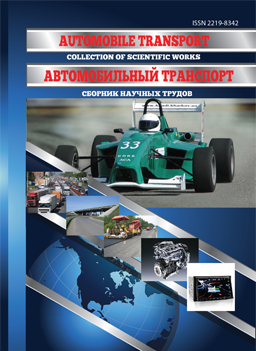The use of intellectual agents in the tasks of information exchange between vehicles
DOI:
https://doi.org/10.30977/VEIT.2018.13.0.48Abstract
To date, one of the ways to improve the efficiency of traffic management is the development of intelligent systems and telecommunications technologies. This approach allows us to create a system in which vehicles, when connected to a common information environment, have the opportunity to exchange current information with each other and other elements of the transport infrastructure. Implement this approach with the help of multi-agent systems. Modern technologies such as Car2Car and Vehicle-to-Vehicle include various electronic vehicle systems, such as electronic vehicle control units, GPS receivers, wireless communication modules and must provide information exchange between road users. Problem: This task, among other things, requires the development of special software (software). Such software should automatically transmit information from the car, receive the necessary information from other vehicles and objects of transport infrastructure and inform the driver about the traffic situation. To solve this problem, you can use the technology of multi-agent systems. This approach is based on the use of special autonomous individuals - agents (agents) integrated into the system. The agent here is a program that is autonomous, capable of performing independent actions in accordance with a given goal. Goal: Determination of the intelligent agent architecture for solving problems of information interaction between vehicles. Methodology: The article considers the question of constructing an intelligent agent that has the ability to take influence from the outside world and from their own kind, to form their reaction to this influence and to carry out this reaction, acting either on its own behalf or on behalf of the user delegating the agent the authority to perform those or other actions. Result: The ability to create intelligent is shown. The questions connected with the peculiarity of the organization of interaction between intellectual agents are considered. Originality: Use of an agent-based approach to solve the problem of information interaction between vehicles. Practical value: The possibility of implementing this technology to address the issues of traffic management.
Keywords: intelligent agent; vehicle; information exchange; Car2Car; agent-oriented programming.
References
Car 2 Car Communication Consortium Manifesto. Overview of the C2C–CC System Retrived from: www.car-to-car.org.
ETSI TS 102 636–3 V1.1.1 (2010–03): Intelligent Transport Systems (ITS); Vehicular Communications; GeoNetworking; Part Requirements Retrived from: http://www.etsi.org/deliver/etsi_ts/102600_102699/10263601/01.01.01_60/ts_10263601v010101p.pdf
Draft ETSI EN 302 665 V1.0.0 (2010–03): Intelligent Transport Systems (ITS); Communications Architecture. European Telecommunications Standards Institute.
Draft Standard for Wireless Access in Vehicular Environments (WAVE). Architecture. IEEE P1609.0/D0.1. Institute of Electrical and Electronics Engineers.
Tarasov V. B. Ot mnogoagentnyih sistem k intellektualnyim organizatsiyam: filosofiya, psihologiya, informatika [From multi-agent systems to intellectual organizations: philosophy, psychology, informatics] Moskow: URSS - Pres [in Russia]
Rassel S., Norvig P.. Iskusstvennyiy intellekt. Sovremennyiy podhod [ Artificial Intelligence. Modern approach 2 ed.]. Moskow: Izdatelskiy dom "Vilyame" – Pres [in Russia]
Agentno-orientirovannyiy podhod [Agent-oriented approach]. Retrived from: https://ru.wikipedia.org/wiki/Agentno-orientirovannyiy_podhod.
Wooldridge M., Jennings N. Intelligent Agents: Theory and Practice. The Knowledge Engineering Review.
Muller J.P. A Cooperation Model for Autonomous Agents/ Proceedings of the Third International Workshop on Agent Theories, Architectures, and Languages (ATAL96), Budapest, Hungary.
Пристатейна бібліографія ДСТУ
Car 2 Car Communication Consortium Manifesto. Overview of the C2C–CC System /URL: www.cartocar.org.
ETSI TS 102 636–3 V1.1.1 (2010–03): Intelligent Transport Systems (ITS); Vehicular Communications; GeoNetworking; Part 1: Requirements/URL:http://www.etsi.org/deliver/etsi_ts/102600_102699/10263601/01.01.01_60/ts_10263601v010101p.pdf
Draft ETSI EN 302 665 V1.0.0 (2010–03): Intelligent Transport Systems (ITS); Communications Architecture. — European Telecommunications Standards Institute, 2010.
Draft Standard for Wireless Access in Vehicular Environments (WAVE) — Architecture. — IEEE P1609.0/D0.1. — Institute of Electrical and Electronics Engineers, 2010.
Тарасов В. Б. От многоагентных систем к интеллектуальным организациям: философия, психология, информатика/ В. Б Тарасов / М.: УРСС, 2002. -352с.
Рассел С. Искусственный интеллект. Современный подход 2-е изд./ Рассел С., Норвиг П. /– Пер. с англ. — М.: Издательский дом "Вильяме", 2006. — 1408 с.
Агентно-ориентированный подход [Электронный ресурс]. – Режим доступа: https://ru.wikipedia.org/wiki/Агентно-ориентированный_подход.
Wooldridge M., Jennings N. Intelligent Agents: Theory and Practice // The Knowledge Engineering Review 10 (2), 1995, C. 115-152.
Muller J.P. A Cooperation Model for Autonomous Agents // Proceedings of the Third International Workshop on Agent Theories, Architectures, and Languages (ATAL96), Budapest, Hungary, 1996, p. 135-147.
Downloads
Published
How to Cite
Issue
Section
License
Copyright (c) 2021 Сергей Викторович Пронин

This work is licensed under a Creative Commons Attribution 4.0 International License.
Автори, які публікуються у цьому журналі, погоджуються з наступними умовами:
1. Автори залишають за собою право на авторство своєї роботи та передають журналу право першої публікації цієї роботи на умовах ліцензії Creative Commons Attribution License, котра дозволяє іншим особам вільно розповсюджувати опубліковану роботу з обов'язковим посиланням на авторів оригінальної роботи та першу публікацію роботи у цьому журналі.
2. Автори мають право укладати самостійні додаткові угоди щодо неексклюзивного розповсюдження роботи у тому вигляді, в якому вона була опублікована цим журналом (наприклад, розміщувати роботу в електронному сховищі установи або публікувати у складі монографії), за умови збереження посилання на першу публікацію роботи у цьому журналі.
3. Політика журналу дозволяє і заохочує розміщення авторами в мережі Інтернет (наприклад, у сховищах установ або на особистих веб-сайтах) рукопису роботи, як до подання цього рукопису до редакції, так і під час його редакційного опрацювання, оскільки це сприяє виникненню продуктивної наукової дискусії та позитивно позначається на оперативності та динаміці цитування опублікованої роботи.








